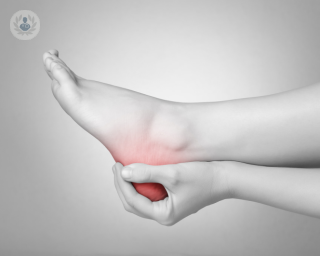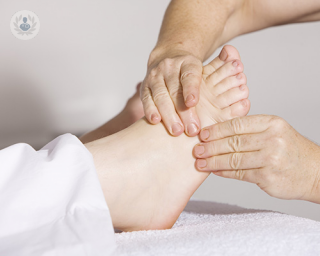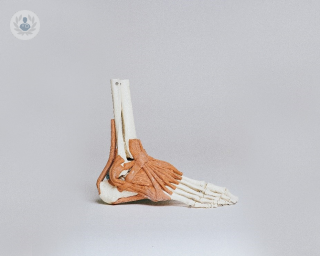Plantar fasciitis
Mr Raj Kumar - Orthopaedic surgery
Created on: 11-13-2012
Updated on: 10-12-2023
Edited by: Kate Forristal
What is plantar fasciitis?
Plantar fasciitis is the inflammation of the plantar fascia by overloading or stretching. The plantar fascia is a thick ligament in the sole of the foot which connects the heel with the toes. This inflammation causes pain as you walk about, usually first thing in the morning, which flares up when standing after sitting for a long period.
An orthopaedic specialist can help to treat plantar fasciitis.

What are the symptoms of plantar fasciitis?
Plantar fasciitis typically presents with several distinct symptoms, primarily centred around the heel:
Heel pain: The hallmark symptom is a sharp, stabbing pain in the heel, often most intense in the morning or after rest.
Aching and burning: Some individuals experience a dull, aching pain or a burning sensation in the heel, which can persist throughout the day.
Stiffness: The heel can feel stiff, making it difficult to flex the foot or point the toes, especially upon waking or after prolonged inactivity.
Swelling: In more severe cases, there may be slight swelling around the heel.
Tenderness: The affected heel and the arch of the foot become tender to the touch.
Radiating pain: Pain can radiate from the heel into the arch of the foot.
Aggravation with activity: Physical activities that strain the plantar fascia, like walking or running, can worsen the pain.
Relief with rest: Rest can alleviate the pain, with discomfort decreasing when off your feet.
How is plantar fasciitis typically diagnosed?
To diagnose plantar fasciitis, the patient’s clinical history is evaluated and a physical examination is performed. The examination determines which stage the plantar fasciitis is at. Following this, the specialist performs a gait analysis and evaluates whether the inflammation of the plantar fascia is related to the way the patient walks. An X-ray scan or MRI scan might be performed to rule out bone problems and potential pinched nerves.
What are the main causes of plantar fasciitis?
The causes of plantar fasciitis is when the tension on the tissue becomes too great, causing inflammation. It is more likely to occur in people who:
- do sports frequently
- are obese
- have a tight achilles tendon
- have foot arch problem
Can plantar fasciitis be prevented?
This can be difficult to prevent, however, maintaining a healthy weight can help reduce the chances of this developing. However, if you frequently do exercises such as running, dancing, or aerobics, plantar fasciitis can develop. In addition, checking that the ankle, Achilles tendon and calf muscles are flexible may help to prevent plantar fasciitis. It may also be helpful to stretch the plantar fascia in the morning before you get out of bed and to perform physical activities in moderation.
Treatments for plantar fasciitis
There are different treatments for this condition but the first option considered is conservative treatments, including rest, applying ice to the painful area and stretching over several months. Massaging and stretching the fascia, can help to provide symptoms relief.
Other, more novel techniques are infiltration of growth factors, intratissue percutaneous electrolysis (EPI) and shock waves, which have all been demonstrated to be highly effective treatments in the acute phase.
Moreover, more and more tools are becoming available for the manufacturing of very precise individualised shoe insoles. One such technique uses a laser to obtain a virtual 3D mould of the patient’s foot.
In very specific cases in which none of the above treatments have worked, plantar fascia surgery should be performed. During this surgery, the tendon is partially or totally released or, if a heal spur is present, the heel spur is reduced. Non-surgical treatments reduce pain in almost all cases. It may take several months before symptoms improve. Some people require surgery to reduce the pain.

















